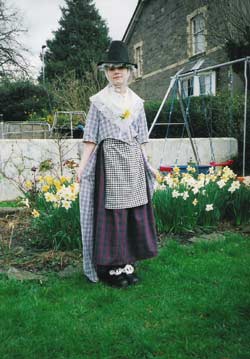St David's Day

by Emily Wright
The First of March is a special day in Wales, our part of the United Kingdom. It is the day we celebrate our national patron Saint, St David. On St David's Day we think about the things that make us proud to be Welsh1. Wales is famous for its beautiful mountains and countryside, for its strong industrial heritage2 in coal and steel production and for its people who are famous for their singing and their playing rugby football. St David lived in Wales around 500 AD and he was a . kind and good man, remembered for setting up monasteries and churches bringing Christianity3 to the Welsh people.
There is a town on the west coast of Wales called St David's where there is a large Cathedral dedicated to him. In our schools, we often celebrate St David's day by dressing in the traditional folk costume of Wales. For the girls this consists of a red checked4 skirt, a white blouse, a lace apron5 or a shawl6 and a tall black felt7 hat. The boys used to wear black short trousers, a white frilly8 shirt and long white socks with shiny9 black shoes. These days the boys tend to wear the red shirt of the Welsh national rugby or soccer football team as their national costume. Most people do not wear the traditional clothes, even on St David's day but they might wear a badge10 of one of the national emblems of Wales, the leek11 or the daffodil12. There are lots of daffodils all over Wales in March. They are a bright yellow flower which bloom in early spring and they make the countryside look cheerful after the cold of winter - a good symbol of the cheerful Welsh people.

Emily Wright dressed in the traditional Welsh costume (Abergavenny, Wales)
Another way we celebrate St David's day in our schools is by holding the annual Eisteddfod13. This is a competition with prizes given for a large number of different categories. The main categories are singing, dancing and playing musical instruments. There are also prizes given for the best poetry reading and for drawn or painted pictures. The singing can be in a choir or individually and the dancing can be a traditional folk dance or a modern dance. The first Eisteddfod was held over 1500 years ago. It was a way of bringing all the people of Wales together to show off their dancing, singing and poetry. Now the main Eisteddfod is the International Music Eisteddfod which began in 1947. People from all over the world come to Wales to compete against each other and perform their national traditional folk music and folk dances.
In our town all the schools get together to compete against each other for our town Eisteddfod on St David's Day. This year I have entered in the competitions for singing in a group, playing the guitar and in the art category. My sister has entered for the singing, playing in an orchestra and the dance categories while Max my little brother has entered a picture for the art competition. There are medals given for 1st, 2nd and 3rd in each category for each age group. Max won 1st prize last year for a picture of a dragon so he is very keen to win again this year. My Mum still has her Eisteddfod medals she won when she was at school so I am looking forward to adding more medals to the family collection this year!
1 Welsh - валлийцы
2 heritage - наследие
3 Christianity - христианство
4 checked - клетчатый
5 lace apron - кружевной передник
6 shawl - шаль
7 felt - войлочный
8 frilly - отделанный оборками
9 shiny - (зд.) начищенный до блеска
10 badge - эмблема, значок
11 leek - лук-порей
12 daffodil - желтый нарцисс
13 Eisteddfod - айстедвод
Читать еще в этой рубрике:
Читать еще в этом номере:
|











